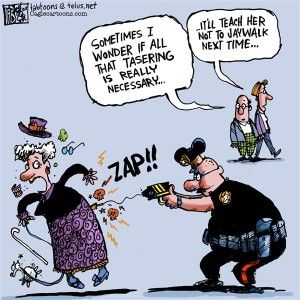Dorner manhunt raises policing issues
by Steven Greenhut | February 17, 2013 8:42 am
 [1]Feb. 17, 2013
[1]Feb. 17, 2013
By Steven Greenhut
SACRAMENTO — Police typically say that their paramount mission is to protect public safety. But the recently concluded manhunt for former Los Angeles Police Department officer Christopher Dorner, accused of murdering four people after releasing a manifesto decrying his 2008 firing from the force, raises concerns about where the public’s actual safety ranks among police priorities.
Last weekend, police opened fire on a 71-year-old newspaper carrier and her 47-year-old daughter, who had the misfortune of driving a pickup truck police thought might be Dorner’s. The Los Angeles police detectives who put two bullets in the older woman’s back didn’t do much double-checking. The women’s truck was a different make and color from Dorner’s.
As the women’s attorney told the Los Angeles Times[2]: “The problem with the situation is it looked like the police had the goal of administering street justice and, in so doing, didn’t take the time to notice that these two older, small Latina women don’t look like a large black man.”
This shooting could be written off as a sad fluke, except that, 25 minutes later, different officers opened fire on a different truck — once again getting key details wrong.
“Nobody trains police officers to look for one of their own,” Maria Haberfeld, a police-training professor at John Jay College in New York, was quoted in a piece on the web site News One. “I wouldn’t want to be in their shoes, and I don’t think anybody else would.”
We all understand the situation. But saying that we wouldn’t want to be “in their shoes” is no excuse for such dangerous police behavior. Police wouldn’t excuse a civilian for misusing a firearm, regardless of how much stress the person was under.
News One also published a photograph of a gray Ford truck seen in the Los Angeles area, bearing a hand-made “Don’t Shoot, Not Dorner, Thank You” poster on the back window. T-shirts and bumper stickers to similar effect have popped up. They’re funny, in a dark way, but police ought to recognize how this reflects on them and their strategies. It’s sad when people are more worried about the police than they are about a murderer on the loose.
Police culture
“Simply put, the police culture in our country has changed,” former San Jose Police Chief Joe McNamara, a Hoover Institution scholar, contended in a Wall Street Journal article in 2006[3]. “An emphasis on ‘officer safety’ and paramilitary training pervades today’s policing, in contrast to the older culture, which held that cops didn’t shoot until they were about to be shot or stabbed.”
The massive scale of the police effort to find Dorner was the result of a killer targeting their own, thus leading to the reasonable conclusion that police pulled out the stops not because the public was in danger, but because they were in danger.
I don’t blame police for their emphasis on catching Dorner, but I also understand why residents in, say, South Los Angeles, might wonder why the frequent killings in their community don’t rate the same attention from authorities.
With crime rates at 40-year lows, this could be an opportune time for a debate about such policing priorities that can be free from excess emotionalism.
Media reports have focused on the rantings within Dorner’s manifesto. But much of what he complained about amounts to bureaucratic indifference — about police officials who, in his mind, didn’t care about the communities they are sworn to protect. Nothing justifies his murderous vendetta, and I’m sickened by people who celebrated Dorner online, but the LAPD said it would re-examine Dorner’s firing. Perhaps the department will try to glean some broader lessons from this tragedy.
Bystanders
Currently, a case before the 9th U.S. Circuit Court of Appeals is evaluating the lengths to which police are required to go to protect bystanders. The case involves Sacramento police, who were trailing a suspect who hid in a tree in a family’s back yard. So an officer released a police dog, Bandit, into the yard, where innocent people were gathered.
Police dogs are trained to bite and hold suspects, but they can’t distinguish between law-abiding citizens relaxing with friends and police suspects. So Bandit attacked the first person it saw. Since then, instead of instituting reform and settling with the family, Sacramento PD has been arguing that “officer safety” would be endangered by requiring a reasonable warning before releasing a police dog on private property.
It’s frightening to think that police can use deadly force without taking even the most modest steps to protect bystanders. It’s even more frightening to hear people defend this approach. Yes, officer safety is important. But so is the public’s safety. It’s time to grapple with finding a proper balance.
Steven Greenhut is vice president of journalism at the Franklin Center for Government and Public Integrity. He is based in Sacramento. Write to him at: [email protected].
- [Image]: http://www.calwatchdog.com/2013/02/17/doerner-manhunt-raises-policing-issues/police-taser-cagle-feb-17-2013/
- told the Los Angeles Times: http://latimesblogs.latimes.com/lanow/2013/02/manhunt-newspaper-carrier-icu-shot-by-police.html
- a Wall Street Journal article in 2006: http://online.wsj.com/article/SB116476867027935258.html
Source URL: https://calwatchdog.com/2013/02/17/doerner-manhunt-raises-policing-issues/